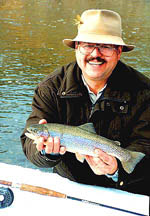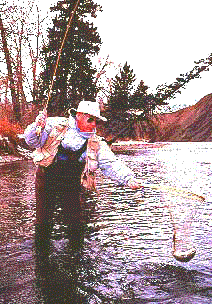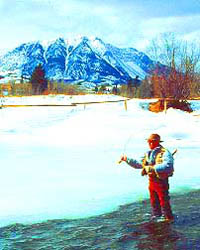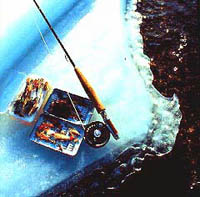Winter Fly Fishing, Eh?
by Clive Schaupmeyer
A couple of days into the new year I mentioned to someone
that I had been fishing on December 30. And, of course, they mumbled something in
reply about "ice fishing."

"No," I gleefully replied. "We fly-fished on the Crowsnest
River! Slayed 'em!" This answer in winter always seems to shorten the
conversation and friends drift away in disbelief as if I was a serial killer and had
just snapped again.
Like many western fly-fishing areas in North America the
opportunities to fly-fish drop off drastically sometime after Halloween and many of
our flowing waters are closed for fishing on October 31. Most of them could not be
fished through winter anyway because they are frozen from around mid-November
through about mid-March, depending on location and season.
But there are a few trout rivers and streams that are
legally open for fishing in Alberta, Canada and, because of natural or manmade
reasons, they have at least some flowing water throughout the winter. So all we need
is a day when the air temperature is above freezing, warm clothes, thermoses full of
hot coffee and a likewise crazy fishing partner.
Not only do we get out, but we usually we catch fish. On
December 30 I hooked around two dozen fish in four hours on the river. I landed
eight, 12 to 17-inch rainbows and a half dozen mountain whitefish. Better action
than in summer. (Of course, all the books say that trout don't feed when the water
is 34°F. Ya right!)
A few years ago my partner, John,  and I made an effort to fly-fish at least
once a month through winter and it more or less worked until the last two bitter
winters. There was one stretch where we fly-fished for 15 straight months and if I
recall we were actually cut short in March - not in the dead of winter as you might
expect. and I made an effort to fly-fish at least
once a month through winter and it more or less worked until the last two bitter
winters. There was one stretch where we fly-fished for 15 straight months and if I
recall we were actually cut short in March - not in the dead of winter as you might
expect.
The only open flowing water I have fly-fished in winter -
December through February - is in the Crowsnest and Oldman Rivers in southwestern
Alberta. (I've fish the Bow River in November and again in March two or three times,
but it's not something I plan.) A few kilometers of The Crow remain open,
no matter how long a deep freeze we have, because warm ground water seeps into the
river. In winter, the water remains open in the Oldman River, below the dam, so
fly-fishing is a possibility any time the weather permits.
Other trout rivers open for fishing include the Bow River,
that flows through Calgary, and the Red Deer River below Dixon Dam. Portions of at
least two spring-fed creeks and rivers west of Red Deer remain open all year,
although snow accumulations are usually higher than in the southern part and can
interfere with access. No doubt I've missed someone's popular winter fishing haunt,
but they likely don't mind that I haven't mentioned it.
The clothes we wear winter fishing depend on the air
temperature and (unfortunately in southern Alberta) on wind.  The Crowsnest River flows out
of the mountains and, no matter what the weather forecast is, we are never sure what
the temperature will be until we arrive - it's a three-hour drive. And even when we
are on the river conditions can change rapidly. So the key for comfort is to dress
in many light layers. The Crowsnest River flows out
of the mountains and, no matter what the weather forecast is, we are never sure what
the temperature will be until we arrive - it's a three-hour drive. And even when we
are on the river conditions can change rapidly. So the key for comfort is to dress
in many light layers.
Typically my main under layers consist of a long-sleeved
mock turtle-neck cotton undershirt, a cotton shirt, a sweat shirt. What goes on over
that (sometimes nothing) depends on the temperature and wind. But I usually wear a
polyester fleece vest and a wind-proof breaker or light winter jacket. A hat is
always a must for head protection while fly-fishing, but also necessary in winter to
reduce heat loss. I wear several different hats depending on mood, wind and
temperature: a felt British-style hat, an oilskin fly-fishing hat, a ball cap or, if
conditions are marginal, a toque - mine is hand knit Cowichan wool head sock.
Most fly anglers who fish in cool or downright cold water
wear neoprenes waders. They come in different thicknesses, but for winter angling
the thick 5-mm neoprene is recommended.
Now I'm going to get into trouble because I am going to tell
you that I do not wear neoprene waders in winter. Since you will have difficulty
accepting what I am about to say, you should know that I have spent more hours in
near-freezing water than most Alberta fly anglers. (Certainly not as much time as
some, just more than most.) And here's what I wear for winter wading: uninsulated
lightweight boot-foot waders with Helly Hansen polyester fleece long underwear over
my cotton twill pants. I usually wear two pairs of cotton or wool socks on my feet.
That's it folks! If I stand in near-freezing water for too long my feet get cold,
but not uncomfortable. And they always warm up if I come out of the water or move
around. (And anyway, my neoprene-clad friends say their feet get cool as well.) My
legs are always warm and dry because body moisture migrates to the outside of the
fleece pants and condenses on the inside wall of the waders and my cotton pants are
always bone dry. On December 30th, 1997 my partner wore his new breathable waders
with fleece pants underneath and was also warm and dry.
Before I get hate mail from neoprene worshipers, please
understand that I've got nothing against neoprenes - except they are stifling hot on
warm spring days and even worse during summer. It's just that I prefer to wear
lightweights with fleece underpants as they are warm and comfortable. You can wear
what you want.
The latest I have successfully fished dry flies in Alberta
was November 15th. And the earliest would be around mid-April. Although we always
see midges on the water and a few flying around, there are never enough bugs or
trout rising (usually none) to justify using dry flies. So winter fishing means
nymph fishing on the bottom. I always use two wet flies. I tie a short section of
tippet to the bend of the main fly and tie a second dropper fly to that tippet.
Successful winter fly combinations include:  a San Juan worm as the main fly with a Black
Mink or midge pupa dropper; or a Black Mink as the main fly with a midge pupa
dropper. Beadhead Prince Nymphs and Hare's Ears are also popular. The key is getting
down where the trout are, and one or two small split shots attached a foot or two up
from the main fly help. In the dead of winter, when the trout are lethargic,
swinging streamers and nymphs does not seem to work too well so we almost always
cast upstream and dead drift flies. Takes are often subtle and it's wise to react to
any slow dip of the indicator. Often the water is low and clear so I avoid the
commercial brightly colored foam indicators and use small pieces of closed-sell
packing foam clove-hitched to the leader. The small white indicator looks like a
small chunk of ice or water foam. a San Juan worm as the main fly with a Black
Mink or midge pupa dropper; or a Black Mink as the main fly with a midge pupa
dropper. Beadhead Prince Nymphs and Hare's Ears are also popular. The key is getting
down where the trout are, and one or two small split shots attached a foot or two up
from the main fly help. In the dead of winter, when the trout are lethargic,
swinging streamers and nymphs does not seem to work too well so we almost always
cast upstream and dead drift flies. Takes are often subtle and it's wise to react to
any slow dip of the indicator. Often the water is low and clear so I avoid the
commercial brightly colored foam indicators and use small pieces of closed-sell
packing foam clove-hitched to the leader. The small white indicator looks like a
small chunk of ice or water foam.
We usually fish when the air is above freezing so are not
usually bothered with ice building on the lines guides. I have never used Chapstik,
but by all accounts it is great for keeping ice from building on the guides.
A couple of cautions. First, a word about safety. Extra care
must be taken when winter fishing and I recommend that you always fish with a buddy
in winter. Don't walk on bankside ice shelves unless you know for certain they are
anchored  solidly to the shallow shore bottom. Be careful crossing bank ice sheets as they can
be treacherous on warm days as a water film forms on the surface. And if you get
cold, get out of the water and warm up. And secondly, a legal warning. Check the
regulations before fishing open flowing water in winter to make sure the water is
legally open for fishing.
solidly to the shallow shore bottom. Be careful crossing bank ice sheets as they can
be treacherous on warm days as a water film forms on the surface. And if you get
cold, get out of the water and warm up. And secondly, a legal warning. Check the
regulations before fishing open flowing water in winter to make sure the water is
legally open for fishing.
Closing thought: experience is what you get when you
don't get what you want.
Return to Index
Copyright ©1998 Clive Schaupmeyer
Clive Schaupmeyer is an outdoor writer and photographer. He is the author of
The Essential Guide to Fly-Fishing,
a 288-page book for novice and intermediate fly anglers. His photo of a boy
fishing was judged the best outdoor picture of 1996 published by a member of
the Outdoor Writers of Canada. He fly-fishes for trout in Alberta's foothill
and mountain streams and for pike near his home in Brooks, Alberta.
Our Man In Canada Archives
|



